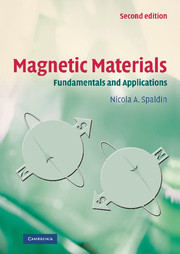Book contents
- Frontmatter
- Contents
- Acknowledgments
- I Basics
- 1 Review of basic magnetostatics
- 2 Magnetization and magnetic materials
- 3 Atomic origins of magnetism
- 4 Diamagnetism
- 5 Paramagnetism
- 6 Interactions in ferromagnetic materials
- 7 Ferromagnetic domains
- 8 Antiferromagnetism
- 9 Ferrimagnetism
- 10 Summary of basics
- II Magnetic phenomena
- III Device applications and novel materials
- Epilogue
- Solutions to selected exercises
- References
- Index
7 - Ferromagnetic domains
from I - Basics
Published online by Cambridge University Press: 05 June 2012
- Frontmatter
- Contents
- Acknowledgments
- I Basics
- 1 Review of basic magnetostatics
- 2 Magnetization and magnetic materials
- 3 Atomic origins of magnetism
- 4 Diamagnetism
- 5 Paramagnetism
- 6 Interactions in ferromagnetic materials
- 7 Ferromagnetic domains
- 8 Antiferromagnetism
- 9 Ferrimagnetism
- 10 Summary of basics
- II Magnetic phenomena
- III Device applications and novel materials
- Epilogue
- Solutions to selected exercises
- References
- Index
Summary
O care! O guilt! – O vales and plains,
Here, 'mid his own unvexed domains,
A Genius dwells…
William Wordsworth, “The Pass of Kirkstone,” The Complete Poetical Works, 1888Ferromagnetic domains are small regions in ferromagnetic materials within which all the magnetic dipoles are aligned parallel to each other. When a ferromagnetic material is in its demagnetized state, the magnetization vectors in different domains have different orientations, and the total magnetization averages to zero. The process of magnetization causes all the domains to orient in the same direction. The purpose of this chapter is to explain why domains occur, to describe their structure and the structure of their boundaries, and to discuss how they affect the properties of materials. As a preliminary, we will describe some experiments which allow us to observe domains directly with rather simple equipment.
Observing domains
Domains are usually too small to be seen using the naked eye. Fortunately there are a number of rather straightforward methods for observing them. The first method was developed by Francis Bitter in 1931. In the Bitter method, the surface of the sample is covered with an aqueous solution of very small colloidal particles of magnetite, Fe3O4. The magnetite deposits as a band along the domain boundaries, at their intersection with the sample surface. The outlines of the domains can then be seen using a microscope.
- Type
- Chapter
- Information
- Magnetic MaterialsFundamentals and Applications, pp. 79 - 95Publisher: Cambridge University PressPrint publication year: 2010
- 2
- Cited by



